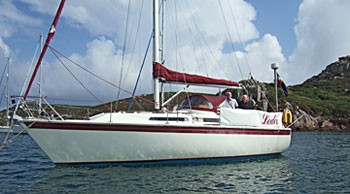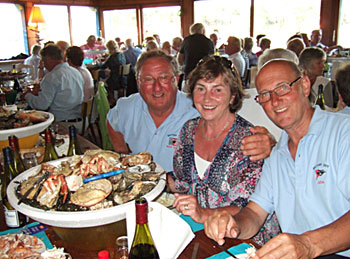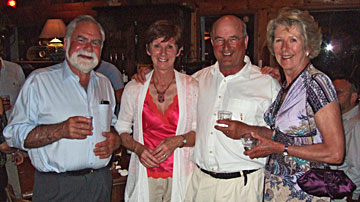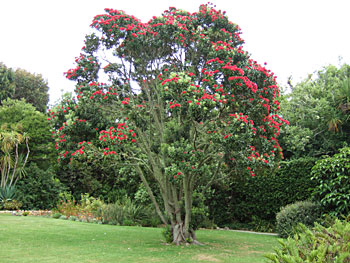|
|
| Leda on the ICC Cruise to Brittany |
| May to July 2011 |
| Posted: 02/10/11 |
|

Leda on moorings in New Grimsby, Tresco in background
|
| Report by Seamus O'Carroll & Photos by Conor Lindsay |
"Leda" departed Howth at 0900 on Monday 13th June crewed by Seamus O'Carroll, Peter Clarke and Conor Lindsay. Initially good progress was made in a 3-4 westerly, passing Wicklow Head at 1230 doing 9 kts over the ground with the ebb tide. After enjoying a nice sunset off Tusker Rock lighthouse; wind dropped off and we motored through the night.
|
Leaving Irish waters.

Tuskar Rock lighthouse and Wexford coast at sunset
|
The following morning revealed a beautiful dawn but by mid afternoon we were into a cold thrash against a force 4/5 southerly. With our speed down to 4kts we decided the Scillies was not a realistic option and bore off for Lands End, eventually getting into Newlyn cold and tired at 0100 Wednesday.
|

Newlyn town from the marina. A functional fishing port
|
Having used up a lot of diesel we tried to get fuel but found under the new regulations we could not buy marked diesel, so had to borrow cans and take a taxi to the nearest filling station a couple of miles away.
We left Newlyn at midday for Camaret in Brittany, into a south-westerly force 3-4. with complete cloud cover most of the way.
|

SS19 "Ripple" the 110 yr old 44' 15 ton double-ended
sailing fishing lugger in Newlyn, recently restored
See website
|
After a bumpy wet passage we approached Le Four lighthouse at the mouth of the Chenel du Four at high water as planned, converging with a dozen other boats also heading south. We were going so well as we approached Camerat we decided to go on for the Raz de Seine.
Eight miles short of the Raz the engine cut out; we were low in diesel and with the rolling of the boat, air may have got in to the fuel line. Without the engine we would miss slack water at the Raz by about an hour and it could be dangerous trying to make it against the tide and the fresh southwesterly, so we turned for Dournanez, fifteen miles to the east.
When we arrived at 1600 they were preparing for a major festival the next day and the marina was full of boats; they kindly let us into a reserved berth on a solemn promise that we would leave before 0800 the next morning. We filled up with diesel, had an excellent but subdued meal in the Port Creperie and walked back to the boat in the rain.
|

"Amitee"
1987 Yole de Bantry 11.65m, races in Gigs Flotilla
in Golfe Morbihan Festival for Boats of Character
|
Douarnenez
Douarnenez is a busy yachting centre with a huge range of boats and sailing facilities, schools etc. Their maritime festival in 2004, a record year, comprised almost 2000 sailing vessels, 17,000 sailors and 30 participating countries, with the emphasis on traditional craft. The mini-Fastnet was lined up to go the next day - see website
|

Douarnenez - pontoons
|
Leda left at 0400 in a light breeze and intermittant rain to make the Raz at 0700 hoping make Benodet by mid afternoon. By the time we reached the Raz at slack water, the wind was southerly 20 knots+ and raining.
The wind and seas steadily increased to 24-26 knots as we slogged southeast towards Pte de Penmarsh; after being battered for an hour we diverted towards Audierne and following an exciting roller coaster approach we tied up at the only free berth at 1000. Other sailors lifted an eyebrow upon our arrival, we were the only boat out that morning. It was cold and showery.
|
Audierne
|

Audierne - pontoons and town
|
We met the crew of Wavedancer from RCYC ,John Daly, Chris Bruen and Bill Cullinane who had arrived the day before and had an enjoyable evening in one of the restaurants on the busy waterfront. The next day, Eileen O'Neill arrived via Rennes and Lorrient. The weather remained cold and showery - not at all like summer holidays in France - and the evening was spent in Cafe du Quai.
The following morning at 0800 we cast off Audierne for Benodet in lighter conditions, but still cold with 10/10 cloud cover.
Benodet
As we tied up in Benodet at 1430, it started raining again. Every place seemed to be closed so wandered about under brollies, eventually ending up in a pizza restaurant, the only place we could find open. It bucketed rain all night.
|

Benodet: Yacht Club de L'Odet
|
On the 20th June we departed Benodet pontoon - in the rain - at 1000 and headed for Port Tudy, Ile de Groix. The rain eased off to fog but at least the wind and sea were moderate. As we approached Ile de Groix the mist cleared and a fitful sun broke through.
Port Tudy on Ile de Groix
The small marina was almost full when we arrived at 1530 as most of the ICC fleet was already there, including Robert and Rose Michael, Sean McCormack and Peter Courtney. With the help of the marina boatman we squeezed into a berth and tied up. The weather was overcast but getting warmer.
|

Port Tudy on Ile de Groix with Saint Tudy ferry to Lorrient in the background
|
We enjoyed a good meal in Auberge du Pacheur after pre-dinner drinks with Robert & Rose Michael and Mike & Janice Alexander. Now that we had reached our first destination, we could relax and the usual 'little nightcaps' became rather bigger.
|

Ile de Groix - ICC Rally boats
|
On Tuesday 21st June the sun shone between the clouds and with no sign of rain Peter and Conor hired bikes and cycled the island. One particular destination worth noting was the huge Menhir de Kermario seen here.
That evening saw the first ICC event which was held in the Salle de Fetes with excellent food provided by Le Jette served by local girls in green "Love Ireland" tee-shirts.
The next day was spent recovering and walking/cycling around the island, visiting Le Grand Phare, Pen Men and P. de Chats.
Thursday 23rd June: 1200 departed Ile de Groix for Belle Ile. We passed the three masted barque 'Belem' which was on route to the Tall Ships Festival in Waterford.
|

Menhir de Kermario
|

Belem
|
Sauzon on Belle Ile
After a pleasant sail we arrived at Sauzon, Belle Ile, looking beautiful in the sunshine, at 1530. The harbour was crowded so we picked up a mooring outside and relaxed with dinner on board that evening (Pork Chops Casserole by Seamus) followed by a drop or two of Jameson as a digestive. The mooring was sheltered but the swell swinging around from the headland made for an uncomfortable night and still cold!
|

Sauzon moorings
|
Port de La Roche Bernard
Friday 24th at 0800 we headed on towards the Villaine River. We reached the mouth of the river at 1300 and just made the lock at the Barrage d'Arzal at 1400 in warm hazy sunshine.
|

Barrage d'Arzal
|
We filled up with fuel and headed on upstream to the beautiful Port de La Roche Bernard, where the clouds vanished starting a mini-heatwave for 2 glorious weeks!!! The next afternoon it was 36degC in the saloon. As we sweltered in the boat, Conor texted that he was in an air-conditioned bar down the waterfront, so we all joined him for the afternoon.
|

La Roche Bernard old port
|

Part of the old town
|
The summer holiday mood at last kicked in and several days were spent walking, relaxing in the sun and sneaking into bars with a/c for chilled beers.
La Roche Bernard is a historic town and the bridge over the Villaine gives terrific views up and down the river; the bridge itself has quite a history.
There are several marinas up the river including two at the Arzal Barrage, Roche Bernard and up as far as Redon. About 30% of the boats are owned by Brits taking advantage of the low rates, a 10 m boat costs less than  2000 p.a. at Roche Bernard ; the overnight rate was 2000 p.a. at Roche Bernard ; the overnight rate was  14, including power and water. 14, including power and water.
While it takes some years to get the essential "passport" for a permanent berth, it also gives two free overnight stays at a list of affiliated marinas along the coast. The most expensive marinas were in Lorient and La Trinite at  32/night, however, most were in the 32/night, however, most were in the  22-28 range. 22-28 range.
|

Two motley crewmen checking the suspension bridge
(Peter & Seamus)
|
On Monday the 27th June we motored back down through the Barrage again - stopping for lunch at Arzal while waiting for the lock.
We locked out at 1500 and got under way for La Trinite Sur Mer.
The passage was really enjoyable in warm dry conditions and we tied up in La Trinite at 2000. The weather remained sunny and warm for the rest of the week.
La Trinite Sur Mer
Peter and Conor took the tourist train to Carnac, these alignments are an extraordinary array of about 6,000 Neolithic menhirs and a UNESCO World Heritage site.
Several HYC sailors were also taking in the sights, including Tom and Mary Fitzpatrick & crew.
|

Leda dressing at La Trinite
|

Carnac
|
The last ICC event was in a seafood restaurant just out of town. Pre-dinner drinks were served with winkles and whelks, only for serious shellfish eaters. We had soup, fish naturally - followed by large platters with a range of crabs, crevettes, oysters, whelks etc placed on the tables.
We were provided with nut crackers, spikes and small oyster forks as well as conventional knives and forks giving some optimists a misplaced hope that there would be a conventional main course to follow, alas the meal finished with a small dessert.
For those of us who like shellfish it was great, but for some who do not like shellfish it was a hungry evening. Eileen luckily saw some children at the next table being served fish and chips so she got the children's meal, excellent.
|

Chris Bruen, Eileen O'Neill, Conor Lindsay and the remains (centre).
|

ICC Dinner group Rupert Jeffares, Helena Courtney, Peter Courtney and Janis Patterson
|
Thursday 30th June: we sailed the 8 miles from La Trinite to Port Haliguen on the Quiberon peninsula.
Port Haliguen
|

Port Haliguen
|
The sun continued to shine and Peter and Conor walked to Fort Neuf and the Pointe du Conguel at the end of the Quiberon peninsula, passing many beautiful beaches along the way. Dinner consisted of ray wings and lots of libations of various kinds.
July 1st saw us leave the visitors pontoon at Port Haliguen for Lorient, suffering from a little mal-de-jameson. We motored past Chaussee and Passage de la Teignouse and ended up at Quai Rohan in the centre of Lorient, rafted up, close to the Valhalla research vessel.
Lorient
|

Research ship 'Valhalla' in Lorient
|
We visited the research ship 'Valhalla', the German Submarine pens, the Eric Taberley centre and around the town generally, all in glorious sunshine. Eileen then headed back for Howth and Richard O'Carroll joined in her place.
|

WW2 submarine pens
|

Inside a submarine, showing torpedo tubes:
|

The Pen Duick boats all together
|
After 2 days Leda headed on to Concarneau on 3rd July, motoring in sun through flat seas again.
|
Concarneau
|

Entrance to Concarneau old town:
|
That evening the crew walked around the perimeter of the town walls. In such weather the major decision is which pair of shorts to wear.
|

Concarneau - town square
|
The following morning we cast off at 0830 and had a bumpy passage through the Raz de Sein an hour after low water in light airs, followed by Robert Michael in Mystique.
|

The Raz
|
Camaret
We arrived at Camaret about 1745. The temperature alarm came on as we were berthing, giving us a wee job to occupy the early evening.
|

Fort Vauban at Camerat
|
The town is quite small but we enjoyed the underground showers beside the Capitanarie and a walk on the seafront. The next morning we knew we were leaving Brittany as it rained intermittently.
|

The old church at the harbour, where a concert was being staged
|
Left France heading for Scillies
At 1400 on 5th July we reluctantly left France and headed toward the Scillies, motoring and sailing in turn. It rained during the night and the westerly wind rose steadily to over 24-27 knots occasionally 34+ - the sea was now rough and with unpredictable wave patterns, waves were washing across the coachroof and as the boat flexed in the lumpy seas - the long saloon windows started to leak on to the berths. Another cold wet passage!
At Tresco in New Grimsby
We arrived in St Mary's Bay at 0930 and with a fresh westerly blowing and forecast to increase, we decided to cross the shallows to New Grimsby where it would be sheltered from the West. Fortunately it was just after high tide and we made the winding passage without incident and picked up the last free mooring.
The moorings at New Grimsby, between Tresco and Bryhr were fine and sheltered but with some swell coming down the channel we rolled a bit at times.
|

Grimsby moorings
|
We had 3 great days in Tresco, motoring in the rubber duck in and out to the harbour, dodging the ferries to the other islands.
|

Seamus and Peter in transit
|
The island of Tresco has many beautiful beaches and the flat terrain is ideal for gentle walking.
|

Beach on East side of Tresco
|
On route to the gardens we passed the heliport where flights arrive from Penzance
|

Chopper arriving
|
The New Inn was our main base, enjoying local ales and good food. It is a busy spot but the service was good and the outdoor area popular in the sun. The sparrows eat out of your hand.
|
For more formal fare a visit to The Island Hotel is worthwhile, with nice walks in the area and good food again. It has time-share apartments for sale / to rent.
|

The Island Hotel
with sculpture in foreground
|

Gardens at Tresco
|

Abbey Garden, Tresco, Chilean "Bottlebrush" tree
|
One whole afternoon was spend visiting the Tresco Abbey Gardens - more info at www.tresco.co.uk - which describes it thus:
"The sub-tropical Abbey Garden is glorious - a perennial Kew without the glass - shrugging off salt spray and Atlantic gales to host thousands of tropical plants."
Included in the tour is an exhibition of salvaged ships' figureheads, a collection of local and other Scillonian island salvage from some of the numerous wrecks around the islands.
|

Valhalla figureheads
|

Peter and Richard admiring a bronze cannon in Valhalla museum
|
Left Tresco heading for Howth
We finally departed on our final leg of the month-long cruise on Saturday 9th July at 1000, running the engine for the first few hours to charge the batteries. The wind was from 270deg initially and veered to 330deg and remained light, 6-7 knots. The cloud cover gradually returned as we sailed north. We were accompanied by dolphins and several occasions during the passage.
By midday on Sunday we were off Rosslare (Splaugh Rock) and our speed picked up from 4.5kts to 7+ kts as the tide turned in our favour. The trip up the Irish Sea took longer than expected and as we would miss the tide at Wicklow Head we decided to break the journey at Arklow so Seamus and Conor could drive back in time for appointments in Dublin.
Peter and Richard brought Leda home to Howth in moderate conditions the next day, finally reaching her berth at 1800 on Monday 11th July, four weeks after she departed.
|
|
|

